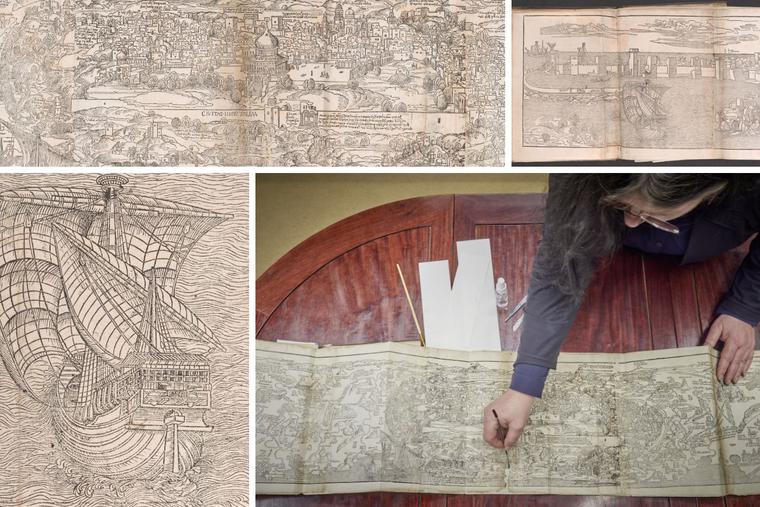The World’s First Travel Guide Will Be Restored
Through an online campaign, the library of the Catholic University of Leuven in Belgium will fund the restoration of the 15th-century ‘Peregrinatio in Terram Sanctam.’

It is considered to be the first illustrated travel guide in history and one of the first faithful representations of the land of Christ a few decades after the invention of printing. Peregrinatio in Terram Sanctam (A Pilgrimage to the Holy Land), a rare 15th-century book, will soon be restored as part of the “Adopt-a-Book” program, a crowdfunding campaign launched by the library of the Catholic University of Leuven,.
The work recounts a pilgrimage to Jerusalem and Mount Sinai undertaken by German clergyman and diplomat Bernhard von Breydenbach between 1483 and 1484. Breydenbach’s text is illustrated by one of his traveling companions, Dutch artist and engraver Erhard Reuwich.
The travelogue was first published in Latin and German in 1486 and was so successful that it was republished several times in the following years and translated into several languages.
“The journey from Europe to the Holy Land was mapped out and illustrated; cityscapes, inhabitants and language were depicted by and for the pilgrim,” Griet Dobbelaere, responsible for the fundraising campaign for the restoration project, told the Register.
From Venice to Cairo
The trip started in Rödelheim, Germany. The travelers then reached Venice and sailed via Corfu, Modon and Rhodes to Jaffa. After visiting Jerusalem and Bethlehem, they went through the Sinai Desert to St. Catherine’s Monastery and returned via Cairo and Alexandria. The journey ended in February 1484 in the German city of Mainz, where printing was invented by Johannes Gutenberg some 30 years earlier.
Panoramic views of Venice, Parenzo, Corfu, Methoni, Herakleion, Rhodes and Jerusalem were faithfully reproduced in the book, which also contains a depiction of the Church of the Holy Sepulchre, as well as plates with figures of Saracens, Jews, Greeks, Syrians, Abyssinians and Turks, and tables with letters of the Arabic, Hebrew, Syrian, Coptic, Ethiopian, Armenian and Greek alphabets.
Giulia Bartrum, curator of German prints at the British Museum, noted that most of the depictions of places such as Jerusalem were inaccurate before this book was published. “Very few people in Europe had ever visited these places so they had no realistic idea of what they looked like until this wonderfully detailed guidebook came along,” she said.
The 500-year-old book also contains chapters on the various religious doctrines of the time, indications about the distances between places on the road from Venice to Jaffa, a detailed calendar of pilgrimages to the Holy Land and Mount Sinai, and advice and remedies to protect travelers from the risks associated with journeys to unknown lands.
The drawings of animals, present in the first version of the work, are not present in the Leuven copy, that is, the Latin edition of Peter Drach, printed in 1490 in the German city of Speyer.
“Peregrinatio in Terram Sanctam is considered a key work of book printing before 1500,” Dobbelaere told the Register. “The University of Leuven is really fortunate to have a copy of this remarkable treasure that is now in bad shape, unfortunately.”
Reversing the Passage of Time
The precious incunabulum belongs to the collection of the Maurits Sabbe Library, the research and heritage library of the faculty of theology and religious studies of Leuven.
According to its experts, the poor condition of the work is the result of the ravages of time, along with a previous unsuccessful attempt at restoration in the 19th century. They estimate the total cost of the restoration work at about 8,000 euros ($8,200 U.S.), explaining on the website that the conservation work will be carried out in the university’s Book Heritage Lab under the leadership of Lieve Watteeuw.
Dobbelaere said, “We’re still looking for funds to help us finance the restoration and save this work so that the many generations to come can be touched by a well-preserved heritage which is the tangible witness of a fascinating past.”
LEARN MORE
The project, which was the subject of a video presentation, is open to contributors from all over the world through the crowdfunding campaign “Adopt-a-Book,” a program launched by the university to ensure the preservation, management and valorization of its valuable heritage collection. Once the work is completed, the guidebook will be fully digitized and made accessible to the public.

















